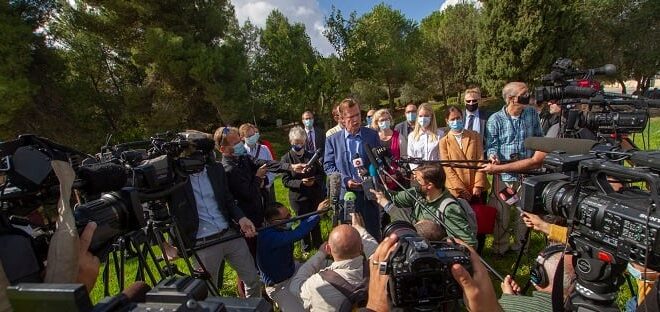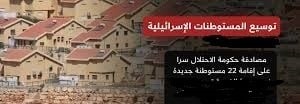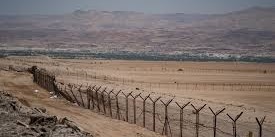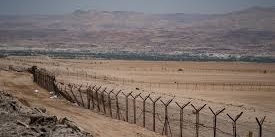By: Madeeha Al-A’raj
The National Bureau for Defending the Land and Resisting Settlements stated in its latest weekly report , that once again, settlement activities have returned to completely isolate Jerusalem from its Palestinian surroundings to prevent the establishment of a Palestinian State, as the Israeli Authorities have formally submitted the plan to expand the ‘Givat Hamatos settlement’, also known as the Hebron Road Strip, for objection, which constitutes a major step in the approval process of the plan. The plan is being officially submitted for public review very quickly, only three weeks after the District Planning Committee moved to approve the plan in last July 15. The plan aims to build 3,500 settlement units and 1,300 hotel rooms on the eastern slopes of the ‘Givat Hamatos settlement’ on more than 140 dunams of land along the Hebron Road.
The plan progresses at a high pace, which is not surprising given the significant increase in promotion and rapid progress of settlement plans since the outbreak of the brutal war launched by the occupying state on the Gaza Strip. It also goes hand in hand with the settlement plans in the region, which aim to isolate the southern side of East Jerusalem from Bethlehem and the southern West Bank, and create more communication with the Gush Etzion settlements.Within the context of revealing the plan, the Israeli human rights association “Ir Amim” pointed out that the ‘Givat Hamatos settlement’ is the first new settlement to be built in East Jerusalem in more than 20 years. It added, “It is clear that the Israeli government is exploiting the current climate to create facts on the ground to prevent any possibilities for a future Palestinian capital in the city.”
The Israeli Local Planning and Building Committee in Jerusalem has approved more than once in recent years the confiscation of Palestinian lands in favor of expanding the aforementioned settlement. Noting that in 2014, this approved a plan to build about 2,600 housing settlement units, but the plan was suspended for years due to international pressure, and the tender for the approved plan was not published, but the situation changed and the Israeli Land Authority later published the tender booklet for the construction of 1,257 unit in ‘Givat Hamatos’ after the tender was postponed for a long time. The Palestine Liberation Organization and many countries have criticized the settlement project because it completely cuts off geographical communication between East Jerusalem and Bethlehem; it also undermines the chances of reaching a political settlement based on the so-called two-state solution.
Noting that, the occupying state has implemented, over the years, the largest illegal settlement projects between Jerusalem and Bethlehem, and has illegally confiscated tens of thousands of dunams and annexed them to the so-called “Jerusalem Municipality” for the purpose of expanding its settlements in Gilo, Givat Hamatos, and Har Homa, and to impose further measures that isolate Jerusalem. The East is separated from its Palestinian surroundings in the north as well as in the south. The plan to expand the “Givat Hamatos” settlement will have a similar effect to the expansion of the settlement project, which the occupying state is planning in the (E1) area regarding the Ma’ale Adumim settlement, in terms of imposing more facts for this isolation plan and the plan to create geographical continuity between the settlements surrounding Jerusalem and the interior of Israel. .
The plan to expand the ‘Givat Hamatos settlement’ comes as an extension of the policy of encircling the city of Jerusalem with more settlements and settlement belts. In the north and northwest, the occupying state established for this purpose the settlements of Ramot, Reches Shuafat, Piscat Omer, Piscat Zeev, Ramat Eshkol, French Hill, Hebrew University, Atarot, and Neve Yaakov. On the southern side are the settlements of Givat Hamatos-Gilo-Hargilo and Har Homa, and on the east are the settlements of Maale Adumim and Kedar, which, along with the Givat Zeev settlement in the north, are within the borders of Greater Jerusalem. With these settlement cordons, the occupation authorities continue their efforts to isolate Jerusalem from its Palestinian surroundings. The northern settlements separated Jerusalem from the northern West Bank, where the governorates of Ramallah, Nablus and the rest of the governorates, and the southern settlements isolated Jerusalem from the governorates of Bethlehem and Hebron.
Two years ago, heads of EU’s representatives, ambassadors and consuls organized a protest visit to the “Givat Hamatos” settlement to express their rejection of the expansion of the aforementioned settlement, as expanding the aforementioned settlement and building a new neighborhood in it would cut off geographical communication between the cities of Jerusalem and Bethlehem. During the visit, the EUnion representative, Sven Kuhn von Burgsdorff, said, “The Israeli announcement of opening the door to bidding for the Givat Hamatos settlement constitutes a source of great concern for the EU and countries with similar positions. This forms part of a worrying trend as Israel continues its policy of strengthening settlements in the territories.” He added, ‘If Israel were to move forward with its plans for a settlement here, it would cause serious harm to the prospects for the establishment of a viable, geographically contiguous Palestinian state.’ More broadly, this would threaten the viability of a negotiated two-state solution, consistent with internationally agreed standards and with Jerusalem as the future capital of two states.
The occupying state’s settlement plans in times of war don’t stop at the borders of encircling and isolating the city of Jerusalem, but rather extend to various governorates, especially Hebron Governorate, which is subject to silent displacement and ethnic cleansing in many of its regions, especially the southern one, through the expansion of establishing and caring for settlement outposts and terrorist pastoral farms. The occupation army imposed a comprehensive closure on it, disrupting life there through checkpoints and closures, besieging the city and erecting military checkpoints and iron gates that closed its entrances, towns and exits.
The occupation forces installed an iron gate at the northern entrance to Hebron – Ras Al-Joura, closed the entrances with cement cubes in all directions, and installed an iron gate at the western entrance to the Tarqumiya town, leading to the Israeli bypass road n. 35, opposite the entrance to the Idna town, and closed the entrance to the town of Idna, which leads to the same road. And the entrances to the towns of Bani Naim, Sa’ir, and Beit Ainun, east and northeast of Hebron, leading to bypass road n. 60.
It set up a military checkpoint at the northern entrance to the city – Halhul Bridge, and another at the western entrance to the city – Farsh Al-Hawa and the southern entrances – Al-Fahs – with dirt barriers, and bulldozed the road leading to “ Khallet Al-Dar” and “Aqabat Najila” and from there to the Yatta countryside, and the iron gate at the entrance to the Al-Samu town’ was also closed in both directions. The occupation forces also tightly closed the southern entrance to Hebron, known as “Al-Harayeq-Hagai,” with an iron gate that they have previously installed on the road leading from the Israeli bypass road 35.
In light of those measures, the occupying state continued its plans to deepen settlement in the governorate by expanding the sponsorship of many settlement outposts, which were established by settlers under the circumstances of the war on the Gaza Strip, in clear exploitation of the public’s preoccupation with the war on the Gaza Strip and the possibilities of the situation developing towards a broader war pushed by Benjamin Netanyahu. Many of these settlement outposts were established by settlers in the Hebron Governorate, which is considered the largest governorate of the occupied West Bank in terms of area and population, with a population of 845,715 people and an area of 1,067 km2.
This area includes Palestinian urban areas, agricultural lands, open areas, Israeli settlements and outposts, Israeli military bases, Israeli bypass roads, and areas classified by the Israeli occupation authorities by military orders as “natural reserve areas,” “forest areas,” “firing zones,” “closed military areas,” “settlement areas of influence,” and names invented by the occupation authorities in order to Controlling Palestinian lands in the governorate.
In light of these measures, the occupying state continues its plans to deepen settlement in the governorate by expanding the sponsorship of many settlement outposts, which were established by settlers under the circumstances of the war on the Gaza Strip, in a clear exploitation of the public’s preoccupation with the war on the Gaza Strip and the possibilities of the situation developing towards a broader war pushed by Netanyahu.
Settlers use settlement outposts as an effective means to control more land in the governorate and turn it into a vital field for settlement expansion and the silent ethnic cleansing operations that are taking place in the governorate. The ‘outpost of the settler Shimon’ and his group, which was established on citizens’ lands in Shomra, from the southern side of the village of Zuwaydin, from the side of Khirbet Umm al-Khair, “the Shuaib community’ from the northern side, and the lands of Fatih Sidra from the eastern side, began to expand to become tents, barracks, and caravans, depriving the landowners of Access to their pastures, and the attacks on them increase, due to the orgy pursued by this extremist settler, like other settlements and settlement outposts, who tampered with and destroyed agricultural crops, uprooted fruit trees in these areas, and unleashed their livestock to destroy what was left of them.
Settlement expanded to the western side of “Shimoun Outpost” and from the Karmiel settlement, all the way to the eastern areas of Deirat, including the Bani Na’im wilderness. The goal is to connect the Bnei Hefer settlement to the Karmiel settlement and seize vast areas of land estimated at thousands of dunams, in addition to a plan to build a settlement road linking these settlements to each other, all the way to the Nabi Yunus area, after the occupation administration last year developed a settlement plan to seize citizens’ lands located between the Karmiel settlement and the Shimon outpost, to connect the outpost to the settlement in a plan to seize the lands located on the southern and eastern sides of the community and to expand the “Atzhar Man” outpost and the Carmiel settlement, which is meters away from Um al-Khair on the western side, to displace citizens from the area, which also has a significant impact on the people of Zuwaidin, who were denied access to their lands.
The focus is expanding towards the village, which is located at the entrance and road to Al-Zwaidin. In addition, there is a major race among settlers who established settlement outposts on the lands of Masafer Yatta, Al-Shifa, and Al-Badia to expand them. On the lands of Al-Ain Al-Bayda and Al-Thaala, there is the “Atzkhaman outpost,” which is also expanding significantly the lands of Um Al-Hayman, the settler “Avichai” and his terrorist group established a settlement outpost that devours citizens’ lands. It is known that the occupation established more than 13 settlement outposts on the lands of Masafer Yatta, with a clear goal, which is to connect settlements, seize lands, and displace citizens, as the residents of several ruins were actually displaced, demolished, surveyed, and controlled.
Through the outposts, the settlements are expanding throughout the governorate and spreading like cancer, as is the case of “Simeon and Asfar” in Seir and Al-Shuyoukh, “Bnei Hefer” in Bnei Naim, “Carmiel, Susya, Masad Yehuda, and Maon” in Yatta, and “Othniel.” “Shaani Levna” in Al-Samou’, “Sham’a, Eshtmu’, and Tana Amrim” in Al-Dhahiria, “Ashkilot, Sinsana (A) and Sinsana (B)” near Al-Ramadin, south of Al-Dhahiria, “Nahal Najhot, and Givat HaPostan” in Dura, and “ Karmi Tzur” between Halhul and Beit Umar, north of Hebron, and “Telem and Adora” in Tarqumiya, and other outposts and settlements.
As for the Al-Musafer area, it is surrounded by 8 settlements, including “Avigail,” “Nof Nesher,” “Mitzpe Yair,” “Khuvat Tsar Man,” and “Khuvat Maon,” in addition to training camps for the occupation army, which leads to the displacement of more population centers there and gives the occupation a free hand in building settlement blocs, such as “Gush Etzion,” “Ariel,” and “Maale Adumim,” and linking them to a road and infrastructure network with southern occupied Palestine.
On the other hand, in a provocative step, the Israeli media reported that a number of Knesset members from the Likud and Religious Zionism parties, in partnership with settler leaders, formed a “civil parliamentary working group aimed at repealing the unilateral “disengagement” law from the Gaza Strip of 2005, in an effort to legislate settlement in the sector, which has been subjected to a devastating Israeli war since last Oct. 8.
This move comes at the initiative of Knesset members, Amit Halevy and Ariel Kellner from Likud, Zvi Sukkot from “Religious Zionism,” and the head of the Northern West Bank Settlements Council, Yossi Dagan, so that they work to draft a law to be presented at the opening of the next session of the Knesset, to join the law approved by the Knesset last March to cancel the plan to disengage from four settlements in the northern West Bank, within the framework of that “disengagement” plan.
List of Israeli Assaults over the Last Week Documented by the National Bureau:
Jerusalem:
- Demolishing a house in the Al-Bustan Neighborhood in the Silwan town belonging to the citizen Moh’d Abd Odeh, consists of 2 rooms with an area of 80m2, and houses 5 of his children and his wife. It is one of hundreds of houses threatened with demolition in order to establish biblical gardens for the settlers.
- Handing over more than 13 demolition notices in various villages and towns of the Jerusalem Governorate in the Damascus Gate, the Jabal Mukaber, Anata, Shuafat Refugee Camp, the Wadi al-Joz neighborhood, and the Kafr Aqab, Hizma towns, the area of Al-Khandaq and Ras Al-Nader in the Beit Anan town, northwest of occupied Jerusalem.
- Issuing a decision to demolish the building of the Wadi Hilweh Center in the Silwan town within a year, and imposed a fine on its director, Jawad Siam, amounting to NIS 20,000. The Jerusalem Governorate said in its report issued at the beginning of this month that the demolitions and notifications during last July amounted in the Jerusalem Governorate to 76 demolition operations, including 10 forced self-demolition operations and 62 demolition operations carried out by the occupation itself, in addition to 4 bulldozing operations.
Hebron:
- Torching dozens of perennial olive trees on citizens’ lands in the Surif town in the Al-Qurinat area, and attacked citizens’ homes in the village of Al-Jawaya in Masafer Yatta, filled in a well belonging to the citizen Najeh Al-Nawaja’a, which can hold 200 cups, noting that the well was dug before 24 years old.
- Attacking citizens’ homes in the Tuba village in the Yata town, south of Hebron, and threw stones at them, causing two citizens to suffer bruises, including a girl. They also tried to steal citizens’ livestock, removed a number of tents that housing more than 10 families, and seized houses in the Berin village, east of Hebron.
Bethlehem:
- Demolishing a house in the Bir Aouna area in Beit Jala, consisting of one floor and an area of 150m2 for the second time, prevented the family from removing some belongings and forced the owner to sign a pledge to pay NIS 100,000 for the demolition.
- Attacking citizens’ vehicles southeast of Bethlehem, near the entrance to the village of Marah Rabah in the south, and on the main road leading to the Taqoa town.
Ramallah:
- Injuring a citizen in the Al-Mughayir village, northeast of Ramallah.
- Storming the “Jabal al-Ras” area east of Safa village, while the occupation forces stormed the village amidst the firing of toxic tear gas towards citizens and their homes, and towards the village mosque, which led to suffocation of dozens of citizens.
- Forcing farmers from the Al-Mughayir village to leave their lands in the Eastern Plain area while they were plowing and preparing them for the next season, young woman, Tasneem Farraj, was injured in her head as a result of being attacked with stones by settlers as she passed near the “Beit El” settlement, on the road between the city of Al-Bireh and the Jalazoun Refugee Camp, then admitted to the hospital.
Nablus:
- Storming the outskirts of Mount Sabih in the Beita town, south of Nablus, and set fire to olive trees., other settlers from the “Yitzhar” settlement also set fire to the lands of the Burin village, and the fire destroyed large areas of agricultural land, causing 2 large fires to break out in the central vegetable market and a vehicle parking lot after they stormed the eastern area of the city to secure the settlers’ storming of Yusuf tomb,” which led to the outbreak of confrontations during which the occupation forces fired bullets and tear gas bombs.
- Attacking citizens’ vehicles with stones near the “Al-Taneeb” intersection, west of the village of Deir Sharaf, causing damage to a number of them.
- Demolishing the village council building of the Furush Beit Dajan village, under construction, consists of 2 floors, with an area of 300m2, fnded by the EU states.
Jenin:
- Demolishing 2houses in the Al-Jalama village, the first for citizen Jamal Abu Farha, with an area of 170m2, and the second for citizen Hashem Mahmoud Abu Farha, with an area of 220m2, under the pretext of building without a license.
- forced citizen Arafat Tawfiq Abu Al-Rub in the village of Jalboun, to demolish the wall of his house, 25 meters long and one meter high, and prevented his brother Mah’d from completing the construction of the wall of his house, even though the two houses were built several years ago, seized the second floor of the house of citizen Rafi’ Rafiq Abu Al-Rub and turned it into a military point in the village.
Tulkarem:
- Bulldozing large areas of agricultural land at the entrance of the Ramin village, east of Tulkarm, all the way to the Ramin plain, which belonged to dozens of families from the village, while a group of settlers stormed the place, accompanied by the occupation forces, and set fire to the agricultural land there.
Jordan Valley:
- Storming the Al-Malihat Arab Community in Al-Marajat, northwest of Jericho, and searched the homes and vehicles of a number of citizens in the area.
- Storming the houses of citizens Yasser Mahmoud Abu Al-Kabash and Sanad Yasser Abu Al-Kabash in the village to the northern of Jordan Valley, stole 2 solar energy systems, 2 refrigerators, and the houses contents.
 المكتب الوطني للدفاع عن الارض ومقاومة الاستيطان منظمة التحرير الفلسطينية
المكتب الوطني للدفاع عن الارض ومقاومة الاستيطان منظمة التحرير الفلسطينية




